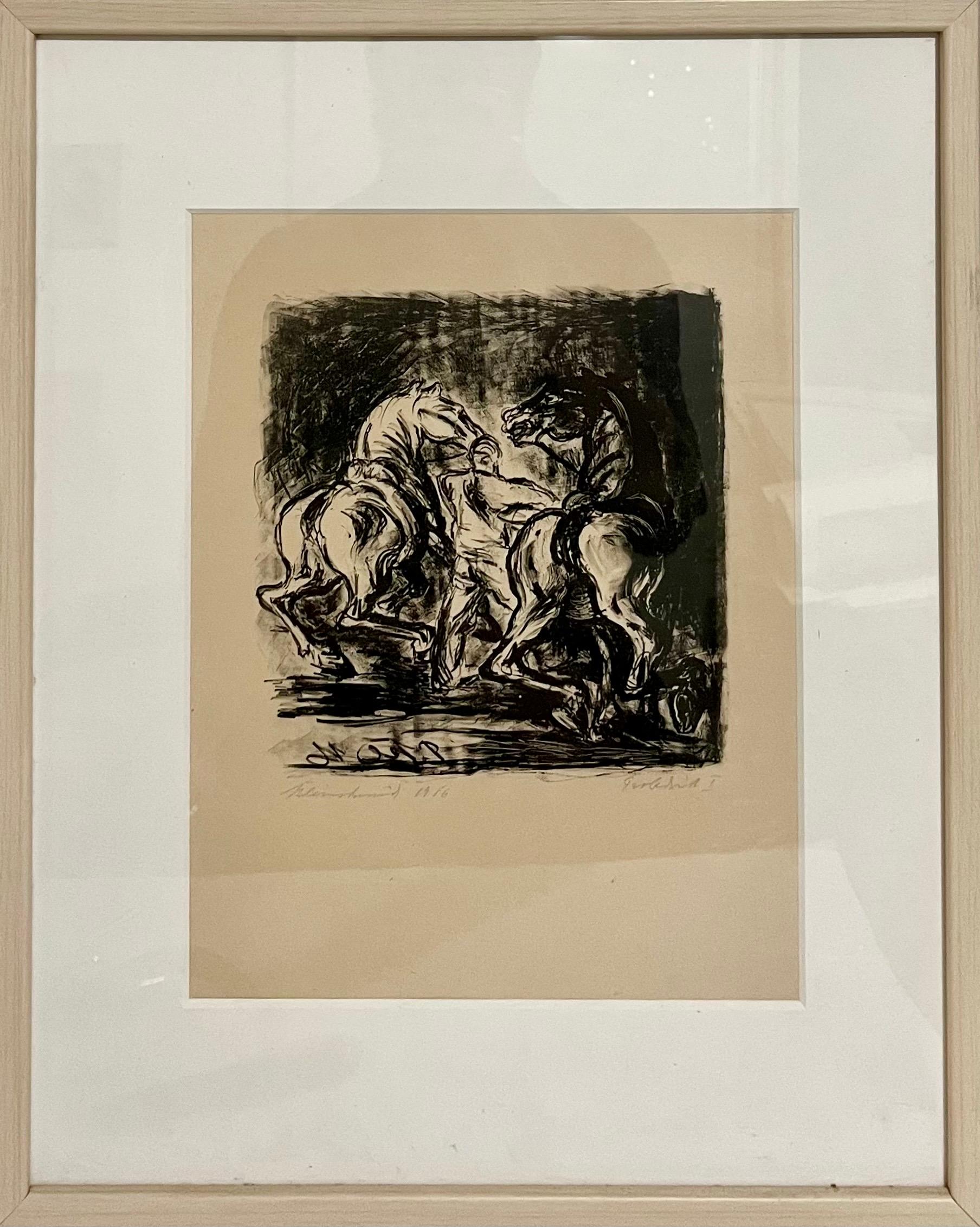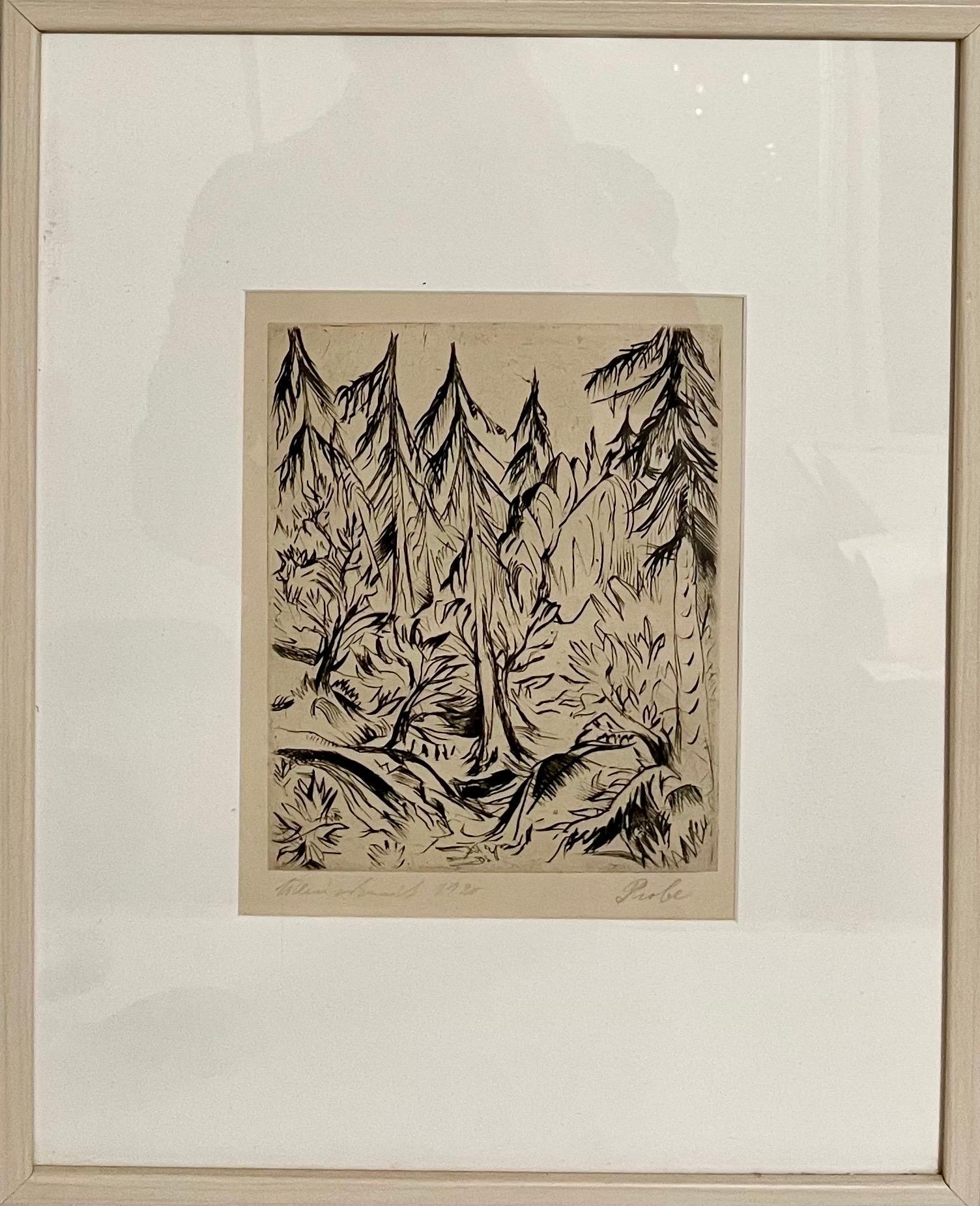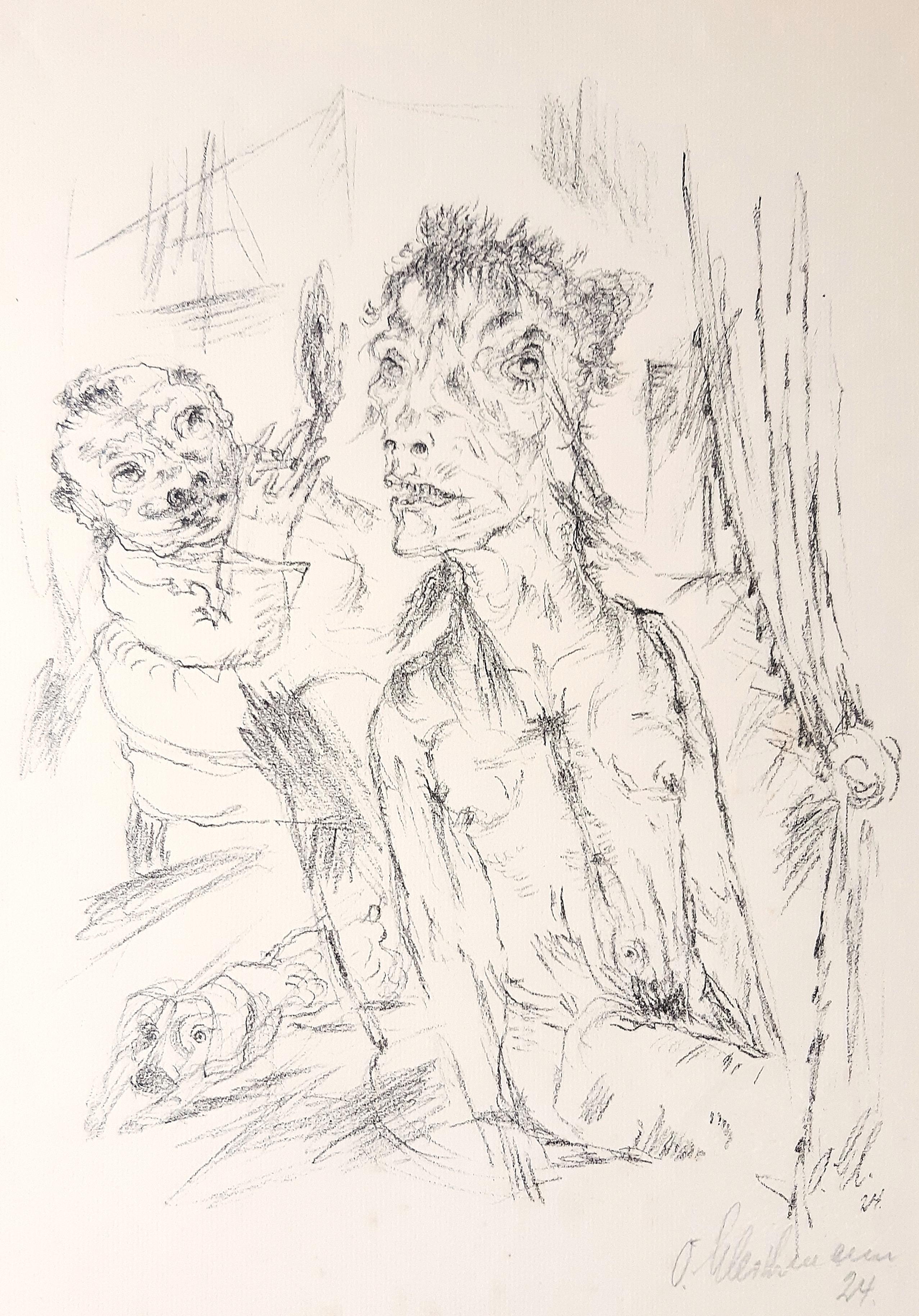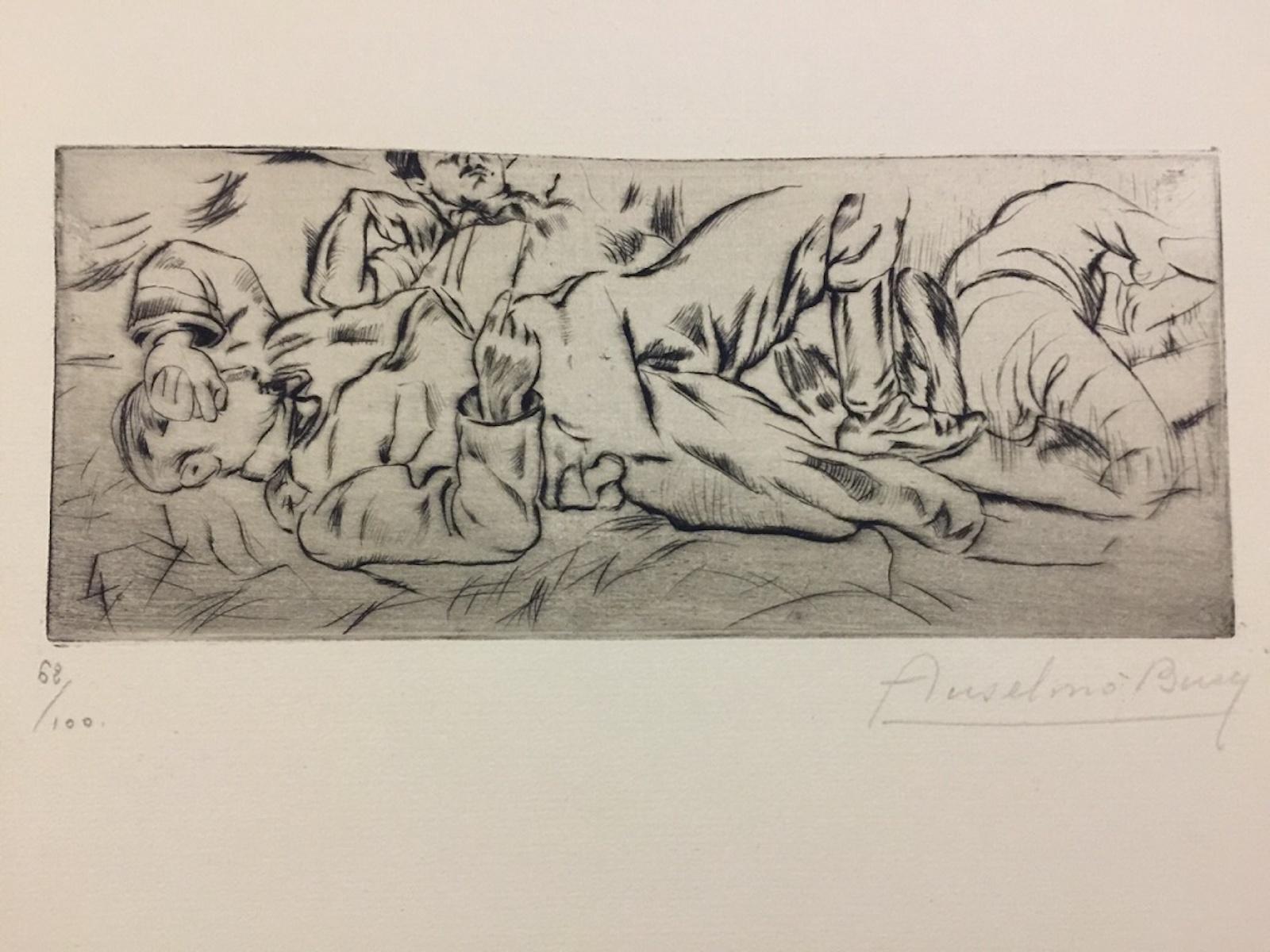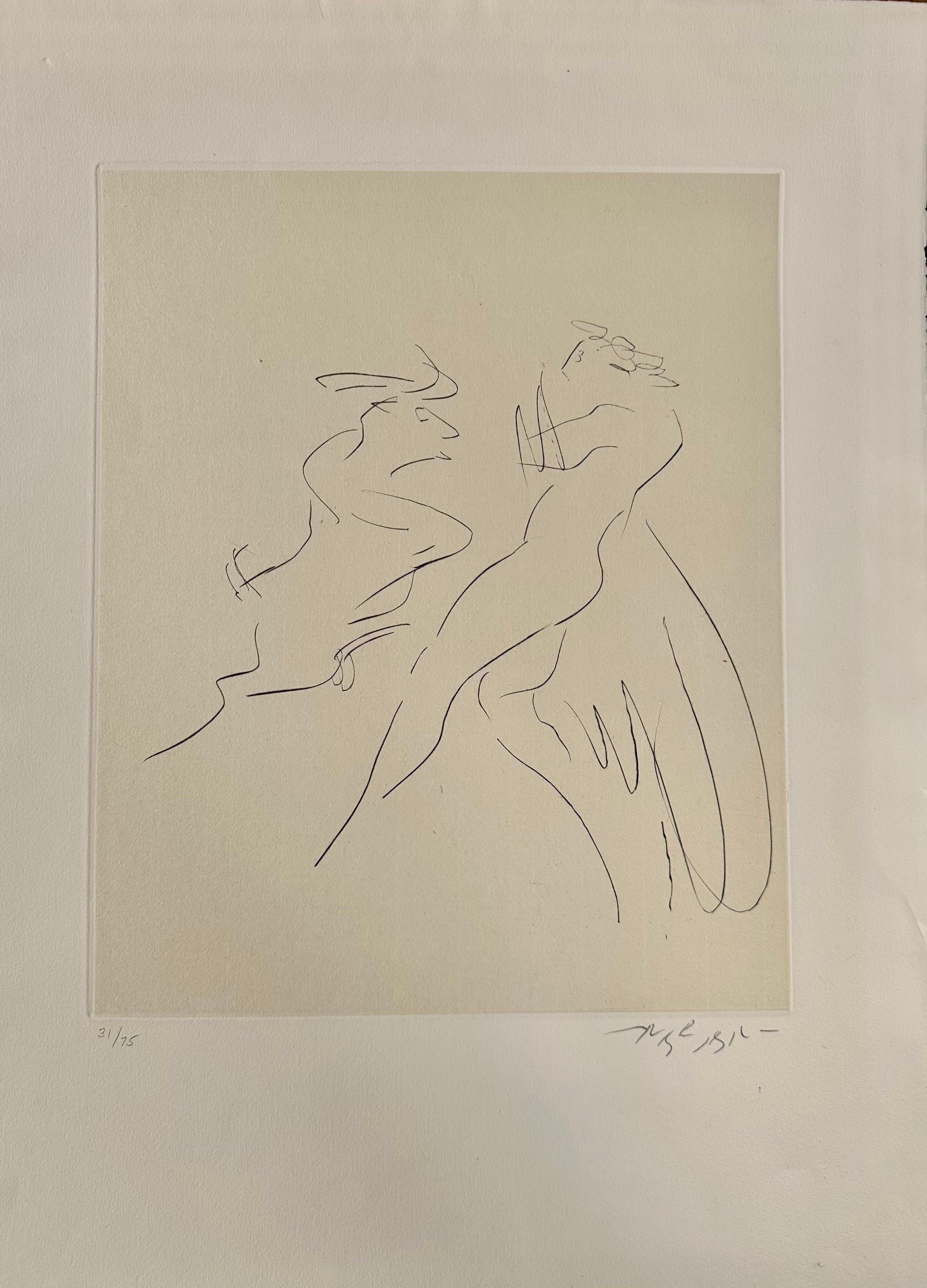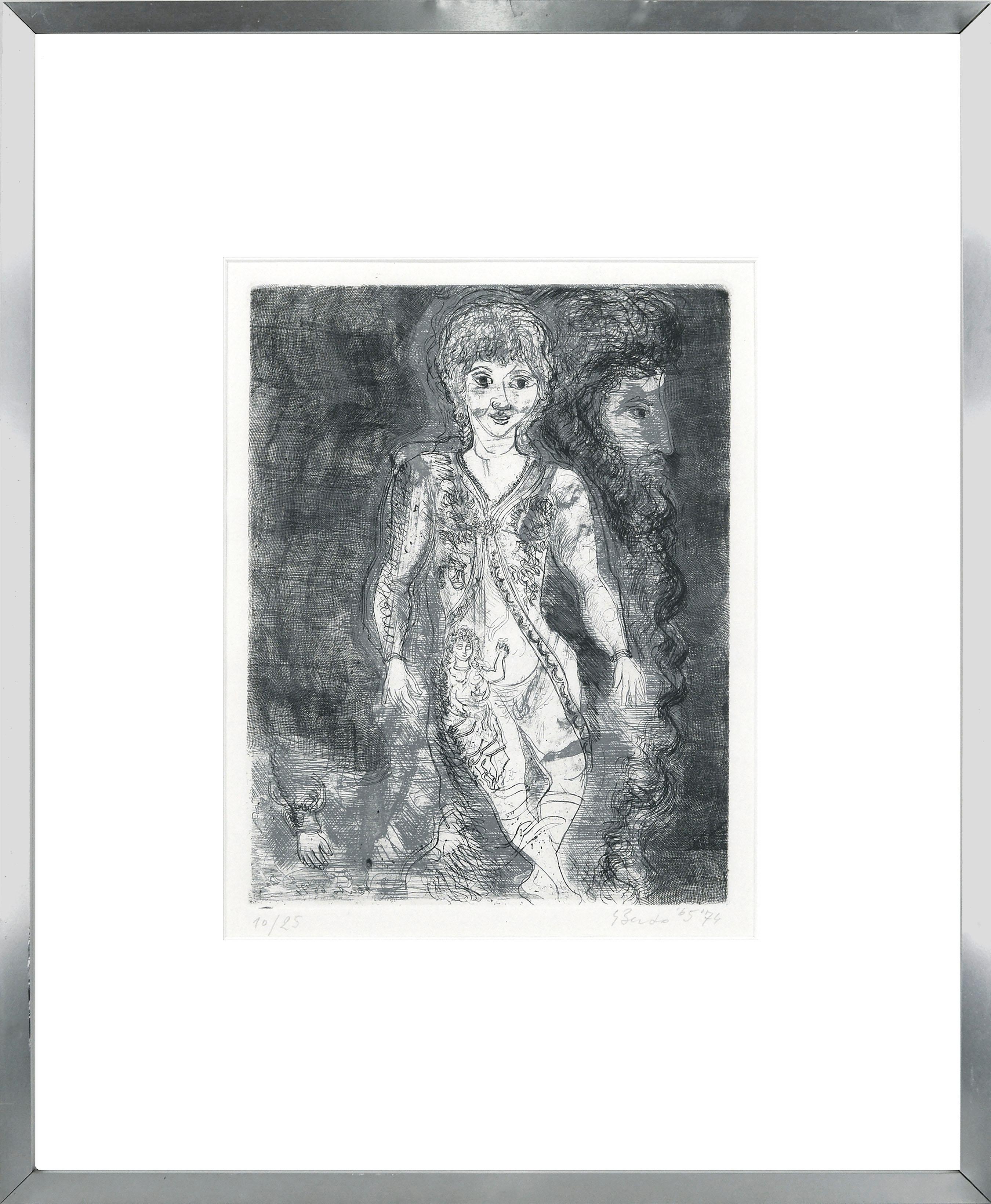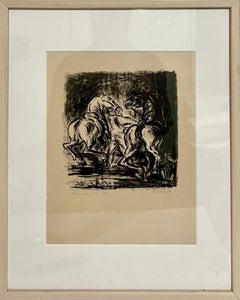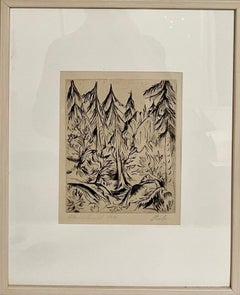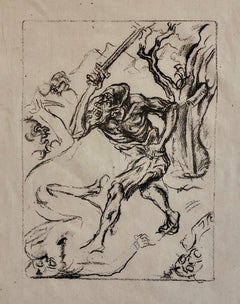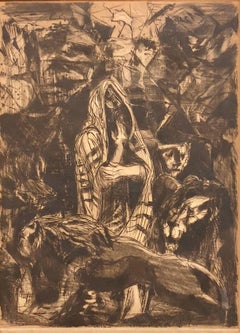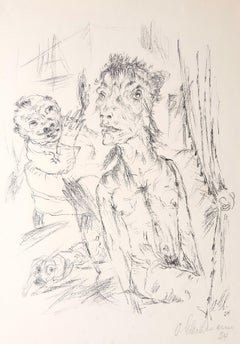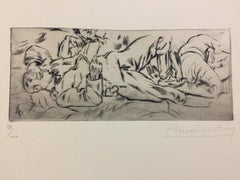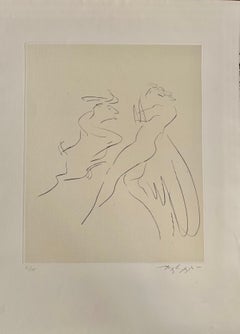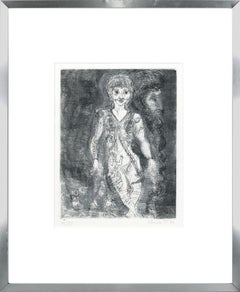Items Similar to 1920 German Expressionist Figurative Etching Daniel with Lion Paul Kleinschmidt
Want more images or videos?
Request additional images or videos from the seller
1 of 9
Paul Kleinschmidt1920 German Expressionist Figurative Etching Daniel with Lion Paul Kleinschmidt1920
1920
$1,250
£972
€1,105.18
CA$1,800.89
A$1,969.04
CHF 1,029.44
MX$23,687.26
NOK 13,026.50
SEK 12,217.71
DKK 8,252.27
About the Item
Paul Kleinschmidt, (1883–1949)
"Daniel" Etching
1920
Frame: 21" X 17"
Image: 9.5" X 7.5"
Daniel in the Lions Den
Rare Artist's second proof
Provenance: bears labels from ACA Galleries and Richard A. Cohn LTD.
Paul Kleinschmidt, (1883–1949) was a Polish born German Expressionist painter. Known for both Impressionism and Expressionism.
Kleinschmidt was born in Bublitz, Pomerania, German Empire (modern Bobolice, Poland). As a student of art at the Berlin Akademie Kleinschmidt's greatest influence was Anton von Werner, who was at the time Kleinschmidt's history art teacher.
During his time as a student Kleinschmidt met Lovis Corinth who became an informative and strongly educational individual for the young student. Kleinschmidt continued his studies in 1904 under Peter Halm's direction, as well as Heinrich von Zügel at the Akademie in Munich. It was in Munich that he learned the techniques of lithography and engraving.
Eventually finding his way to Berlin to work as a painter and graphic artist, Kleinschmidt exhibited at the 'Sezession' shows in 1908 and 1911.
Many important artists were active or joined, Max Beckmann, Ernst Barlach, Wassily Kandinsky, Kathe Kollwitz, Emil Orlík, Lyonel Feininger, Hans Meid, Edvard Munch, Max Pechstein, Max Liebermann, Emil Nolde were all Berlin Secessionists. In 1915, Kleinschmidt began teaching drawing while also taking the role of a technical draughtsman, during which time a great majority of his most remarkable lithographs and engravings were created. Offering these pieces in his first solo exhibition, organized by the Euphorion publishing company in 1923, Kleinschmidt's work would next see light in 1925 at Fritz Gurlitt in Berlin, thereafter graduating to a painting oriented focus. Kleinschmidt was first introduced to a New York City art collector by the name of Erich Cohn in 1927. A man who later became his sponsor. Kleinschmidt made several rapid moves from Berlin throughout Southern Germany in 1932 ending up in Ulm and within a year's time, Ay near Senden. Shortly thereafter, he and his family found a great struggle in the midst of a political repression. Finally finding a path of emigration to the Netherlands in 1936, Kleinschmidt relieved himself and family of such political angst, from there to France in 1938.
Kleinschmidt's pictorial world is mostly dominated by dazzling, exuberant and sensual women, whom he portrayed as modern monuments of femininity. Oil painting Inspired by the Berlin nightlife of the 1920s as well as by his childhood spent in a traveling circus, he uses expressive painting techniques to locate barmaids, waitresses, prostitutes, dancers and circus riders draped with erotic accessories or cake buffets in the milieu around bars, cafés and variety shows. The National Socialists took offence at such depictions and ostracized Kleinschmidt's art. They confiscated some of the works and showed some of them at the Munich exhibition Entartete Kunst, "Degenerate Art" in 1937 along with the best of German Expressionism. In addition, he was banned from painting, but this could not dissuade him from continuing his work. He was taken prisoner in February 1940 throughout several camps for a short span but released again post-French capitulation. George Grosz has written of Kleinschmidt as one of the great German Expressionist artists. "Kleinschmidt occupies a special position in German art and is a master in his own right. His place is between Lovis Corinth and the Expressionists." Kleinschmidt was forced to stop painting in 1943 under direction of the Nazis during his final years in Bensheim. In 1945, the entirety of his possessions were lost to an air raid. Kleinschmidt died on August 2, 1949, as result of a severe angina pectoris diagnosed in 1940.
Paul Kleinschmidt has been in four exhibitions at MoMA, NYC
German Painting and Sculpture April 1931 with Paul Klee, George Grosz, Ernst Ludwig Kirchner and Max Beckmann and others.
Summer Exhibition: Painting and Sculpture, October 1932
with Pablo Picasso, Henri Matisse, Paul Klee and Fernand Léger etc.
Recent Acquisitions, 1968–1973 September 1973
with Henri Matisse, Joan Miró, Georges Braque and Jasper Johns etc.
The Expressionist Idiom, December 1985 withPablo Picasso, Henri Matisse, Paul Klee and Georges Rouault, among others, were invol
- Creator:Paul Kleinschmidt (1883 - 1949, German)
- Creation Year:1920
- Dimensions:Height: 21 in (53.34 cm)Width: 17 in (43.18 cm)
- Medium:
- Movement & Style:
- Period:
- Condition:Please refer to photos.
- Gallery Location:Surfside, FL
- Reference Number:1stDibs: LU38215043332
About the Seller
4.9
Platinum Seller
Premium sellers with a 4.7+ rating and 24-hour response times
Established in 1995
1stDibs seller since 2014
1,826 sales on 1stDibs
Typical response time: 1 hour
- ShippingRetrieving quote...Shipping from: Surfside, FL
- Return Policy
Authenticity Guarantee
In the unlikely event there’s an issue with an item’s authenticity, contact us within 1 year for a full refund. DetailsMoney-Back Guarantee
If your item is not as described, is damaged in transit, or does not arrive, contact us within 7 days for a full refund. Details24-Hour Cancellation
You have a 24-hour grace period in which to reconsider your purchase, with no questions asked.Vetted Professional Sellers
Our world-class sellers must adhere to strict standards for service and quality, maintaining the integrity of our listings.Price-Match Guarantee
If you find that a seller listed the same item for a lower price elsewhere, we’ll match it.Trusted Global Delivery
Our best-in-class carrier network provides specialized shipping options worldwide, including custom delivery.More From This Seller
View All1916 German Expressionism Figurative Lithograph Man Two Horses Paul Kleinschmidt
By Paul Kleinschmidt
Located in Surfside, FL
Paul Kleinschmidt, (1883–1949)
"Man & Two Horses" Lithograph
1916
Frame: 21" X 17"
Image: 13.5" X 10.5"
Rare Artist's Proof
Provenance: bears labels from ACA Galleries and Richard ...
Category
1910s Abstract Figurative Prints
Materials
Lithograph
1920 German Expressionist Figurative Lithograph "The Forest" Paul Kleinschmidt
By Paul Kleinschmidt
Located in Surfside, FL
Paul Kleinschmidt, (1883–1949)
"The Forest"
Lithograph on Cream Paper
1920
Frame: 21" X 17"
Image: 10.75" X 8.5"
An expressionist forest scene with pine trees
Provenance: bears label...
Category
1920s Abstract Figurative Prints
Materials
Lithograph, Paper
Jakob Steinhardt Jewish German Expressionist Lithograph Israeli Early Bezalel
By Jacob Steinhardt
Located in Surfside, FL
plate signed.
Jacob Steinhardt
1887-1968
Steinhardt, Jakob, Painter and Woodcut Artist. b. 1887, Yaacov Steinhardt was born in the then remote, largely Polish town of Zerkow in the Posen District of Germany. (poland/german) Immigrated 1933. Studies: 1906 School of Art, 1906 Studied in Berlin Arts and Crafts School. Berlin; 1907 painting with Lovis Corinth and engraving and etching with Hermann Struck; advanced studies, 1908-10 Paris, with Henri Matisse and Steinlen; 1911 Italy. Teaching: Bezalel, Jerusalem, 1953-57 Director. 1910 Participated in the “New Sezession”, Berlin. 1912 together with Ludwig Meidner and Janthur he founded the "Pathetiker" group very early in the German expressionist movement. Running afoul of the Nazis, he fled to Tel-Aviv and then Jerusalem in the early 30s, showing in “Der Sturm” Gallery. 1914 Exhibited with ludwig Meidner at first Expressionist Exhibition in Berlin. Worked mainly in woodcuts depicting biblical and other Jewish subjects. 1955-58 International awards for his woodcuts. receives graphic commissions from Fritz Gurlitt. 1922 Marries Minni Gumpert. Active in organizing Secession exhibits. 1925 Trips to Mark Brandenburg and Holy Land. Turns primarily to painting; stops work on etchings and lithographs. 1933 Emigrates to the Palestine. 1934 Moves to Jerusalem and opens an art school; attempts some etchings. 1948 Closes the art school and becomes Chairman of Graphics Department, Bezalel School for Arts and Crafts. 1954-57 Director of Bezalel School for Arts and Crafts. Taken up by J. B. Neumann who became the agent for his etchings. Exhibited Sturm Gallery, Herbst-salon. 1914 Outbreak of World War I; Steinhardt enlists in German army. 1916-18 First on Eastern Front in Poland and Lithuania, then after short training period in Berlin, sent to Macedonia. 1917 Exhibition of Lithuanian drawings at Berlin Secession in Spring. Elected member of the Secession.
He often used wood-cutting techniques that were popular amongst German Expressionists. Steinhardt was driven to express ideas clearly and decisively through art.
Amongst the themes found in his work the prophets of the Bible, such as Jonah, are noticeable. Steinhardt identified deeply with Jonah due to his attempt to run from God's call to duty.
Additionally, the image of beggars was often found in Steinhardt's works and in his artistic presentation of the less fortunate, the artist's love for his fellow man becomes evident.
Moreover, the grotesque was a theme noticeable in Steinhardt's earliest pieces. These were fantastical images; it was unclear whether or not they were human or demon. In the 1950's, Steinhardt returned to these images upon learning of the Holocaust of Europe's Jews. At that time he resided in New York and there, in the shadow of the skyscrapers, Steinhardt's reaction to WWII was expressed through his art.
A Collection of Works by Artists of the Land of IsraelThe Bezalel National Museum, Jerusalem 1940 Artists: Shemi, Menahem Rubin...
Category
20th Century Expressionist Figurative Prints
Materials
Woodcut
Modernist Daniel in Lions Den Biblical Judaica Etching Israeli Artist
Located in Surfside, FL
Daniel In Lions Den. Artist proof etching. it depicts a rabbi wrapped in a tallit surrounded by lions. A very well executed work of a famous miracl...
Category
20th Century Modern Figurative Prints
Materials
Etching
Large Donald Saff Surrealist Pop Art Aquatint Etching Wolf, Man
By Donald Saff
Located in Surfside, FL
Artist: Donald Saff
Title: Wolf and Man
Year: 1980
Medium: Etching with Aquatint, Hand signed and numbered in pencil
Edition: 50
39 in. x 27.5 in.
Donald Jay Saff (born 12 Decemb...
Category
1980s Pop Art Figurative Prints
Materials
Etching, Aquatint
German Neo Expressionist Graphite Drawing Erwin Pfrang Nolan Eckman Gallery NYC
Located in Surfside, FL
Erwin Pfrang, German (b. 1951)
Graphite on paper
Partner Exchange (2001)
Framed 21 X 14.5 sheet 13.75 X 7.25
Erwin Pfrang (born 1951, in Munich) is a German painter and printmaker...
Category
Early 2000s Neo-Expressionist Figurative Drawings and Watercolors
Materials
Paper, Graphite
You May Also Like
Bordellszene - Original Lithograph by Otto Gleichmann - 1924
By Otto Gleichmann
Located in Roma, IT
Bordellszene is an original lithograph, realized by Otto Gleichmann in 1924, hand- signed and dated.
In very good conditions.
Here the artwork represents two men in Expressionistic...
Category
1920s Expressionist Figurative Prints
Materials
Lithograph
Spleen - Original Etching by Anselmo Bucci - 1917
By Anselmo Bucci
Located in Roma, IT
Image dimensions: 9 x 21 cm.
Hand signed. Edition of 100 prints on Hollande paper. From the collection: “Croquis du Front Italien” , published in Paris by D'Alignan editions. Anse...
Category
1910s Futurist Figurative Prints
Materials
Drypoint, Etching
Reuben Nakian, "Nymph and Goat 1", hand signed etching
By Reuben Nakian
Located in Chatsworth, CA
Reuben Nakian
Nymph and Goat 1
1979
Original etching
Hand Signed by the artist in pencil
Numbered 31/75 from the edition of 75
Paper Size: 26 x 20 inches
Image Size: 16.5 x 13.5 inc...
Category
1970s Modern Figurative Prints
Materials
Etching
Mid Century Modern Figurative Etching of a Man & Woman, Signed Limited Edition
By Gianpaolo Berto
Located in Soquel, CA
Detailed mid-century modern figurative abstract etching by Gianpaolo Berto (Italian, 1940-2003). This etching features a central female figure, with layers of detailed embellishments...
Category
1970s Modern Figurative Prints
Materials
Paper, Etching
Militant - Original Etching by Anselmo Bucci - 1917
By Anselmo Bucci
Located in Roma, IT
"Military" 1917 is a beautiful print in etching technique, realized by Anselmo Bucci (1887-1955).
Hand signed. Numbered 89/100 of prints on the lower left. On the lower left corner,...
Category
1910s Modern Figurative Prints
Materials
Etching
Manfredi - Etching and Drypoint by Anselmo Bucci - 1917
By Anselmo Bucci
Located in Roma, IT
Manfredi - from "Le Croquis du Front Italien" is an Artwork, Drypoint, realized by the Italian Artist Anselmo Bucci, in 1917.
Hand signed on the right margin . Edition n. 37/100 specimens on Hollande paper. From the collection: “Croquis du Front Italien” , published in Paris by D'Alignan editions.
Good conditions, except for a light yellowing of the paper.
Anselmo Bucci (1887-1955) was an Italian painter and printmaker.
He took part in the Salon des Indépendants from 1910 on. He enlisted in the Volunteer Cyclist Battalion in 1915 and he became one of the most famous Italian war...
Category
1910s Modern Figurative Prints
Materials
Etching, Drypoint
More Ways To Browse
Antique Work Light
Antique Print Lion
Durer Original
Dylan Glaser
Etching On Silk Print
Fake Street Art
Flog Art
Frank Sinatra Hirschfeld
Grosz Interregnum
Hand Signed Norman Rockwell
Hector Julio Paride Bernabo
Henri Matisse Nadia
Henry Monnier
Henry Moore Sculptural Objects
Hirschfeld Nina
Hockney Parade
Hokusai Woodblock Prints
Horse Woman Picasso
